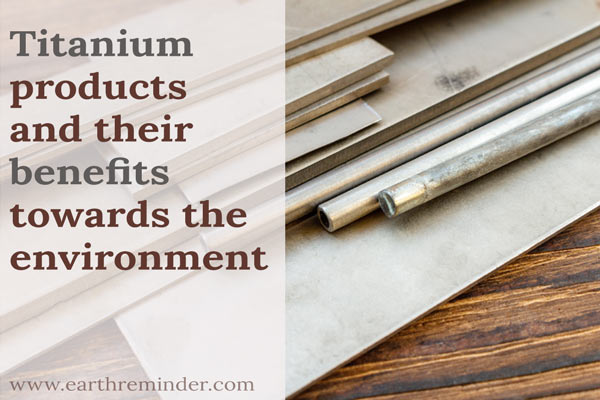How Can Titanium Products be Beneficial for the Environment?
Titanium products and their benefits towards the environment
Titanium is the most common element available in the earth’s crust. Titanium metal is a metal most commonly originating in animals and plants. It can naturally interact with oxygen to create titanium oxides, commonly found in ores, indigenous specks of dust, sands, and soils. Titanium is the most eco-friendly material for environmental safety and sustainability.

Table of Contents
Titanium for biodiversity and environmental protection:
Ti improves plant performance: Ti’s biological role in plants has been studied for more than 100 years, and it is observed that it enhances plant growth and an inherent constituent of the ash from all plants. Ti actively participates in plant metabolism as a redox catalyst.
It increased plant growth and development and increased the intensity of green color. Ti-ascorbate are water-soluble, with pH value of 8, and also non-toxic to animals. Titanium is one of the most beneficial elements to crop development, and with the increase of crop production, the crisis of hunger can be minimized and maintain biodiversity.
Exceptional Properties of Titanium as Eco-Sustainability:
Titanium is 100% recyclable Eco metal
Since metallic Titanium does not permanently deteriorate because Titanium does not rust .it is easy to recycle, and it is an environmentally friendly metal. Besides Titanium has a low density and a high specific strength, it can be made small and light, and transportation machines and others can be expected to improve fuel economy.
Titanium products do not deteriorate semi-permanently; they can continue to be used forever. In other words, it does not get in the process of recycling because of its lifetime concerning that; there is no doubt that it is extremely ecological.
Titanium cleans itself
The recent discovery proves that titanium oxide has photo-catalytic action and super-hydrophilic action. Photo-catalytic process decomposes organic matter to risk-free level by exposure to ultraviolet light to titanium oxide. The super-hydrophilic effect of titanium oxide is exposed to ultraviolet light. By this process the ability to water is significantly improved. The titanium oxide film became a super hydrophilic state.
Both actions are very useful for environmental sustainability. When ultraviolet rays are applied to titanium oxide, electrons become high energy states, and excited electrons are formed. This is the same principle as the solar cell, but this excited electron is extracted as an electric current to the solar cells’ external circuit.
In contrast, in the photocatalyst, excited electrons and holes react with molecules on the surface to decompose. It causes a high oxidation reaction. The characteristic of titanium oxide photocatalyst holes which are generated by light are very strong oxidizing ability.
What is Titanium Dioxide?
Titanium oxide has stronger oxidizing power than hydrogen oxidation and ozone, usually used as strong oxidizing agents. Due to strong oxidizing power, substances adsorbed on the surface are broken in their molecular state, oxidized and decomposed to their final oxidation products. It is effective for deodorization, sterilization, and anti-fouling.
Uses of Titanium oxide
Titanium dioxide is used in vast applications that require high opacity and brightness. Surfaces that contain white, pastel or dark color hold titanium dioxide on them.
Pigmented titanium dioxide is used in daily applications, including:
- Paints and high-end Coatings:
Titanium dioxide provides cloudiness and durability to the product. It ensures the paint’s longevity and protects the air as it doesn’t generate harmful fumes from the painted surface.
- Rubber and Plastics:
Titanium dioxide can aid in minimizing the fragility, desertion, and cracking in plastics and other materials due to light exposure.
- Cosmetics products:
Pigmented titanium dioxide is used in cosmetics to hide blemishes and brighten the texture of skin.
- Food productivity Materials:
The dullness to visible and ultraviolet light offered by titanium dioxide protects food, supplements, pharmaceuticals and beverages, from premature degradation, increasing the shelf life of products. Titanium dioxide is also used in pharmaceutical, capsule top coatings, and decorative support to foods.
Eco-friendly Synthesis of Titanium Dioxide Nanoparticles
For a few years, nanoparticles have been widely being used for several human purposes. This is an efficient way of using nanomaterials instead of using any toxic materials. However, the involvement of some nanomaterials for several commercial purposes is costly, and finding a non-toxic one is a tedious task.
To overcome all those problems, scientists discovered titanium dioxide nanoparticles, which are cost-effective and eco-friendly, that we could easily apply the effectiveness of Titanium products to their full extent.
In this way, we can manage our waste efficiently as wastes are the raw materials for synthesizing titanium dioxide nanoparticles.
Fruit peels are used to extract such materials in an economy friendly manner. After the extraction and synthesis, the characterization of such molecules is done by using several analytical techniques. Some of these laboratory assays are performed to evaluate antibacterial, antioxidant activities, and further analysis of free radicals, hydrogen peroxide, and even nitric oxides.
Analytical characterization techniques include XRD (X-ray diffraction), FTIR and SEM analysis, and also UV-spectroscopy.
Conclusion:
Research and development have opened the way to save our earth and its elements from destruction. Through the advancement in research in the past few decades, analysis and synthesis of Eco-friendly materials have increased.
One of the most effective results we get through a consistent study on several elements is the effectiveness of Titanium dioxide. Its application is not only cost-effective but a pathway for us to reach our sustainable development goals earlier.
If you like this article, feel free to share it with friends and gain knowledge together to save environment.